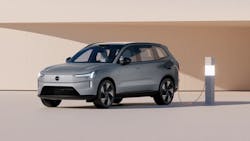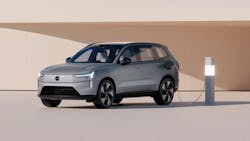Level-4-Ready 2024 Electric SUV: A Technology Tour de Force
This article is part of TechXchange: LiDAR Technology
What you'll learn:
- The advanced technology integrated into the EX90 SUV.
- Details regarding the rooftop-mounted Iris LiDAR system.
- ADAS features, including driver monitoring.
According to Volvo, its forthcoming EX90 will be a visionary all-electric SUV positioned above its flagship gasoline-powered XC90. The vehicle will incorporate all of the hardware required for fully unsupervised (SAE Level 4) driving in the future.
The most obvious and striking ingredient making autonomous operation possible in the 2024 model is a built-in LiDAR system that continuously scans the environment in front of the car, enabling an accurate estimate of the shape and size of objects in three dimensions. The EX90 will employ what’s claimed to be the first rooftop-mounted LiDAR unit on an international-market passenger vehicle.
The LiDAR, developed by Florida-based Luminar and known as “Iris,” uses a scanning mode with larger scanning mirrors than the more typical MEMS mirrors. Iris’s light source is a 1550-nm fiber laser. The longer wavelength (905 nm is more typical) is said to be harmless to the human eye.
Luminar’s Iris LiDAR will be integrated into the front roofline to optimize for safety and performance, with form following function. The teardrop-shaped housing enables airflow to pass over and creates as little turbulence as possible. Water nozzles at the end of the EX90’s windshield wipers clean the LiDAR’s protective screen.
Inside the Iris
Iris uses pulsed, time-of-flight (ToF) target illumination that Luminar engineers say delivers a very fast measurement rate without speed-dependent range error. It scans a vehicle’s surroundings in real-time, firing laser pulses to create a virtual 3D map, with no need for GPS or a cellular connection. The LiDAR itself has a 120-degree field of view (FoV) and a 26-degree dynamic vertical FoV.
The LiDAR’s receiver incorporates indium-gallium-arsenide (InGaAs) microchip technology rather than silicon. Resolution is claimed to be greater than 300 points per square degree.
There are other things about LiDAR that enhance advanced driver-assistance systems (ADAS) systems. Cameras can have difficulty with darkness, poor weather, or blinding light. Conversely, Luminar’s Iris can detect and classify objects to a maximum range of 600 meters (1969 ft.), even at night. It’s able to detect a pedestrian or animal scurrying across the road at up to 250 m (820 ft.) and can spot any other type of object in the road at up to 120 m (394 ft.).
Luminar CEO Austin Russell noted that from the start Luminar’s strategy has been to enable advanced safety and unlocking autonomy in driving for companies with production vehicle programs. This stands in stark contrast to most autonomous-vehicle companies and programs that are building small fleets of self-driving robo-taxi prototypes with the goal of replacing ride-hailing drivers, rather than focusing on technology for safety, ADAS, and highway autonomy on production vehicles. The answer, he says, is “by enhancing the driver, not replacing the driver, which has always been our objective.”
Defying predictions that LiDAR would remain too expensive, bulky, or complicated for production vehicles, the Iris’s 2-axis scanner spins only the laser rather than spinning the whole LiDAR device.
More Tech Advances
The remainder of the technology package scheduled for the 2024 SUV includes an exterior sensor set that in many ways is more evolutionary than revolutionary: The EX90 will be outfitted with eight cameras, five radars, and ultrasonic sensors.
The finalized version of the EX90’s hardware and software will support other ADAS elements that dovetail with SAE Level 2 functions such as automated emergency braking, pedestrian/cyclist detection, and adaptive cruise controls. The new sensors will improve the reliability and performance of Volvo’s assisted-driving Pilot Assist system, including new steering support during lane changes.
In its press statement, Volvo said, “Our sensors don’t get tired or distracted. They are designed to respond and react when you’re just a millisecond too late. Our LiDAR senses the road in front of you, whether it’s day or night, also at highway speeds. It can see small objects hundreds of meters ahead, creating more time to inform, act, and avoid.”
As its cars hit the roads and Volvo learns from the data generated, company research indicates that the software and sensors can help reduce accidents that result in serious injury or death by up to 20%.
A camera in the EX90’s interior handles driver monitoring. It uses artificial intelligence (AI) that can detect not only driver inattention, but also driver intoxication or medical impairment. Powered by Volvo’s own in-house developed algorithms, the system can gauge eye gaze concentration. This enables the Volvo EX90 to understand when you’re distracted, inattentive, or drowsy, and when the car might need to step in for support.
If the car detects any sign of the driver being unresponsive, it can brake the car to a standstill within the lane. The camera works in conjunction with a cabin-focused onboard radar capable of detecting the breathing of occupants, from a strapped-in infant to a slumbering pet, to ensure nobody is accidentally left behind.
Computing Power
The EX90’s neural network for AI application requires powerful computational ability. A core system—powered by NVIDIA DRIVE AI platforms Xavier and Orin, Snapdragon Cockpit Platforms from Qualcomm Technologies, and in-house-developed software by Volvo engineers—runs most of the core functions inside the car, from safety and infotainment to battery management.
NVIDIA-based core computing will use machine learning and collect data to help Volvo understand and refine operating behavior. With the new hardware implementation, the data collected by Volvos will go into driving simulations to improve performance in real-world scenarios, with improvements delivered via over-the-air (OTA) updates.
Speed and Range
If your taste in driving excitement runs more toward Porsche racing than Tesla environmental responsibility, fear not. Acceleration should be brisk even though the EX90 will likely tip the scales at a higher curb weight than its gasoline-powered cousin, the XC90.
The initially available twin-motor all-wheel drive version will be powered by a 111-kWh battery and two permanent-magnet electric motors, together delivering 370 kW (496 hp) and 671 ft.-lb. of torque in its performance version. Volvo says the Twin Motor model should be capable of hitting 60 mph in 5.7 seconds, while the Twin Motor Performance version will be able to reach 60 mph in 4.7 seconds.
The large battery pack also promises to recalibrate your expectations with a driving range of about 300 miles on a single charge, according to the WLTP test cycle, and the ability to be recharged via a dc fast-charging connection. Range, of course, depends on various factors like driving style, road topography, temperature, wind, and other factors such as how much electricity is used for heating and cooling of the car.
The EX90 is the first electric vehicle to use the new SPA2 (Volvo Scalable Product Architecture platform 2). The coming years will see Sweden’s Volvo, owned by Geely Holdings of China, integrating the roof-mounted sensor on other models built on its SPA2 platform, including the South Carolina-built Polestar 3 from Volvo’s new EV division.
Starting with the EX90, Volvo says it will reveal one new fully electric car each year. By 2030, according to CEO Jim Rowan, “We aim to sell only fully electric cars, one of the most ambitious electrification blueprints in the automotive industry and crucial to our ambition to be a climate-neutral company by 2040.”
The EX90 will go into production in 2023 for deliveries in 2024. The EVs will be assembled at the Volvo plant in Chengdu, China. All Americas-bound Volvo EX90 models are expected to be built at the company’s plant in Charleston (Ridgeville), South Carolina.
Read more articles in TechXchange: LiDAR Technology

